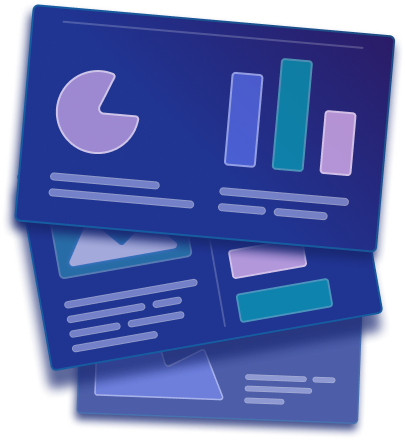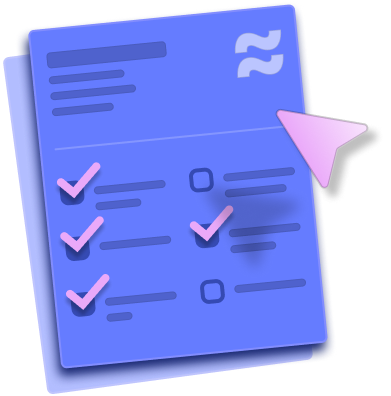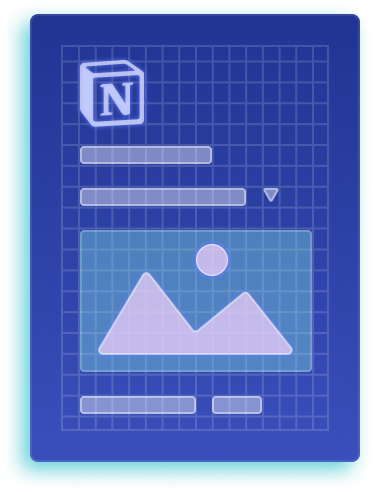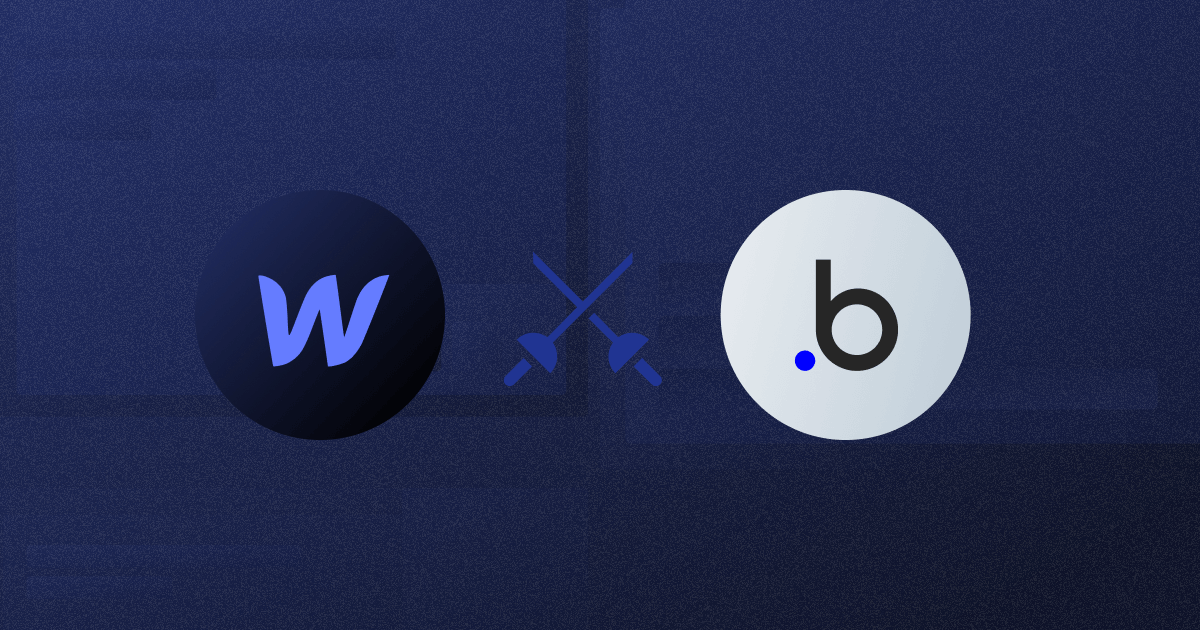
Build SaaS with Webflow: Pros and Cons
Even though Webflow is mainly a web design tool that offers visual frontend development, its capabilities reach far beyond that.
If you were wondering whether it was possible to build SaaS — yes, it is. However, Webflow alone won’t do the trick. You will have to connect it to supporting services that will assist you, including Wized, Xano, Memberstack, and more.
If you’re interested in learning how we used different tools with Webflow to create a SaaS platform, take a look at the following video.
In the article below, I will discuss the main advantages and disadvantages of using Webflow for building SaaS. Moreover, I’ll list the standard process of doing that and mention some useful tools along the way.
{{cta}}
Pros of Using Webflow for SaaS Development
As mentioned, Webflow alone won’t be able to do much, but if you decide to combine it with other no-code SaaS development tools, here’s what Webflow will bring to the table.

1. Ease of Use and User-Friendly Interface
Webflow stands out for its intuitive, user-friendly interface. This visual development platform allows users to build SaaS interfaces without deep coding knowledge.
The drag-and-drop functionality simplifies the design process, making it accessible even for those with limited technical expertise.
This democratization of design and development enables a broader range of creators to bring their SaaS ideas to life quickly and efficiently.
2. Rapid Prototyping and Deployment
One of the significant advantages of Webflow is the speed at which developers can prototype and deploy a SaaS platform.
The platform's design-first approach, combined with real-time preview features, allows for quick iterations and modifications.
This rapid development cycle can significantly reduce the time-to-market for SaaS products, an essential factor in the fast-paced tech industry.
3. Customization and Design Flexibility
Webflow offers extensive customization options, allowing developers to create unique and visually appealing SaaS platforms.
Unlike template-based platforms, Webflow provides granular control over the design elements, enabling the creation of bespoke user interfaces that can enhance user experience and engagement.
This flexibility ensures that the SaaS product stands out in a crowded market.
4. Integrations and Extensibility
The platform supports a wide range of integrations and plugins, making it a versatile tool for SaaS development. Whether it's integrating with CRM tools, analytics, or marketing platforms, Webflow's extensible nature allows for seamless integration with various third-party services.
This extensibility is crucial for SaaS platforms, which often rely on a diverse ecosystem of tools and services.
Cons of Using Webflow for SaaS Development
Webflow comes with some downsides, which is why it’s not considered the first choice for users interested in building no-code SaaS. Let’s take a look at them.

1. Scalability Challenges
While Webflow is excellent for prototyping and small to medium-sized projects, it may face challenges when scaling a SaaS platform.
As user numbers grow, the platform might not handle the increased load as efficiently as more robust, dedicated SaaS development environments.
This limitation can be a significant drawback for SaaS applications anticipating rapid user growth.
2. Dependency on Custom Coding
Despite its ease of use, achieving specific functionalities in Webflow often requires custom coding. This need can introduce complexities, particularly for users who chose Webflow for its no-code/low-code appeal.
Relying on custom code might require additional resources or expertise, which could offset some of the platform's initial ease-of-use advantages.
3. Pricing and Subscription Model Constraints
Webflow's pricing model, based on site plans and account plans, can become costly as the needs of a SaaS platform grow.
For startups or individual developers, these costs can add up, especially when additional features or higher tiers are needed. Understanding and managing these costs is crucial for long-term planning and budgeting.
4. Technical Limitations and Restrictions
There are technical constraints with Webflow, particularly regarding backend development and complex application functionalities.
While it excels in frontend design, Webflow may not offer the same level of flexibility or capability for backend processes crucial for SaaS applications.
This limitation may require the use of additional tools or platforms.
SixStar: A Real-World Example of Webflow-Backed SaaS
In Flow Ninja, we decided to create an in-house client experience platform that will help clients track hours, see available tasks, ongoing tasks, and much more. The essence of this tool is Webflow, although we connected external tools, such as Xano and Wized, to help us with the back-end.

{{cta}}
How to Build a SaaS with Webflow?
Building a SaaS (Software as a Service) platform with Webflow involves a series of steps that combine Webflow's design and development capabilities with various integrations for backend functionality, membership management, and other advanced features.
Here’s a step-by-step guide including the integration of tools like Xano, Wized, MemberStack, and others:
1. Define Your SaaS Concept and Requirements
Conceptualize your SaaS product, including its purpose, target audience, and key features.
At this stage, you need to list technical requirements and define what your SaaS needs to do, the features it must have, and any specific user interaction elements. Ultimately, you’ll find your answer to whether you should use Webflow in this step.
2. Design the User Interface with Webflow
In case you decide to use Webflow as one of your tools, create a Webflow account and familiarize yourself with its interface. The important things to pay attention here:
- Design the frontend — Use Webflow's visual editor to design the user interface of your SaaS. This includes creating landing pages, user dashboards, and other interactive elements.
- Responsive design — Ensure your design is responsive and works well on all devices.
3. Integrate Backend Functionality
Webflow doesn’t have backend capabilities, so you will need an external tool. Perhaps the best choice here is Xano.
- Xano — Use Xano for backend development. It allows you to create a powerful, scalable backend without extensive coding. It can handle databases, server-side logic, and API creation.
- Set up APIs — Connect Webflow with Xano via APIs to ensure seamless data transfer and functionality between the frontend and backend.
4. Add Membership and User Management
In most cases, your SaaS will require users to register to use it. Integrate MemberStack for managing user accounts, subscriptions, and payments. This is crucial for SaaS platforms that require user login, subscription management, and payment processing.
5. Include Advanced Functionalities and Customizations
This is where things get a bit tricky, as Webflow is limited when it comes to SaaS functionalities. That’s why we often rely on Wized, which was built for Webflow.
- Wized — Use Wized to embed no-code web apps directly into your Webflow project. It’s particularly useful for adding custom features that are not natively supported by Webflow.
- Integrate other tools — Depending on your SaaS requirements, integrate tools for analytics, customer relationship management (CRM), marketing automation, etc. We covered a range of popular Webflow integrations on our site.

6. Set Up Hosting and Domain
Pick one of the Webflow site options for hosting and connect a domain.
- Webflow hosting — Set up hosting with Webflow, which provides fast performance and easy SSL certificate management.
- Custom domain — Purchase and set up a custom domain for your SaaS platform.
7. Test and Optimize
Before launching your SaaS, it’s important to test it and make sure it’s performing optimally (although this is very difficult to achieve right from the start)
- Conduct user testing — Test the platform with real users to identify any usability issues or bugs.
- Optimize performance — Use Webflow third-party tools to optimize loading times, SEO, and overall performance.
8. Launch and Market Your SaaS
Once everything is set and tested, launch your SaaS platform. At this point, you should consider implementing digital marketing strategies, such as content marketing, PPC advertising, and social media marketing, to attract users.
This is mostly done outside Webflow, but the popular visual builder can play an important role in almost any marketing strategy. For example, if you’re focusing on content marketing, Webflow’s CMS can help you quickly upload and publish content.
9. Monitor and Iterate
After your project is live, you don’t want to leave anything to chance.
- Analytics — Regularly check analytics to understand user behavior and platform performance.
- Iterate — Continuously update and improve your platform based on user feedback and performance data.
Additional Tools to Consider
- Zapier/Integromat — For automating workflows and connecting Webflow with other online services.
- Airtable/Google Sheets — For database management and integration.
- Mailchimp/HubSpot — For email marketing and CRM functionalities.
Conclusion: Webflow as Part of Your SaaS Initiative
To sum up, building SaaS frontend with Webflow is possible, but the backend part will require making various integrations and using third-party tools to make it all work in unison.
Should you decide to build SaaS and include Webflow in your toolbox, make sure to get in touch with Flow Ninja and see how we can help you grow your project.
{{cta}}





Free Webflow Launch Checklist
After working on 200+ Webflow projects, we've compiled a checklist to use before launching your site.
.png)

.png)

in mind?
Talk with our team and learn how your ideas can become digital experiences.

.svg)





-min.png)





.webp)
.png)
.png)



-min.png)

-min.png)









.svg)

.png)
.png)
.webp)
.svg)


